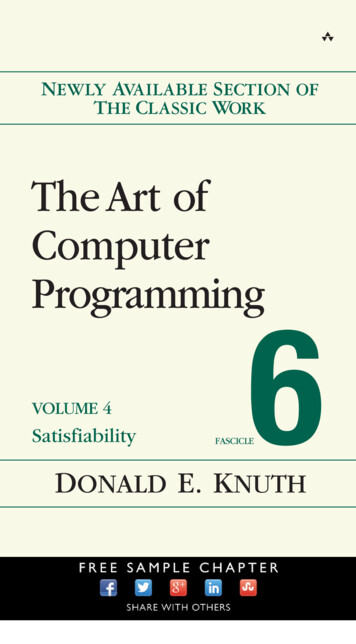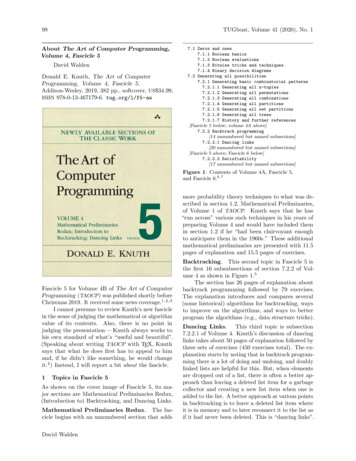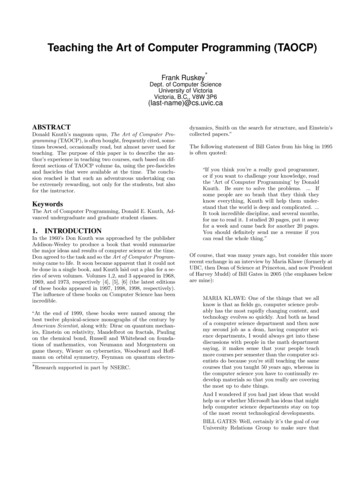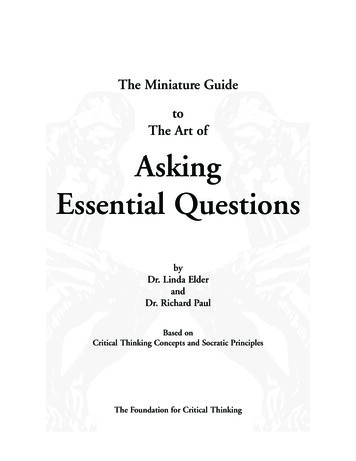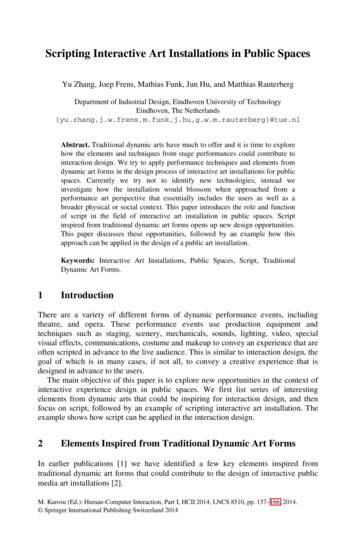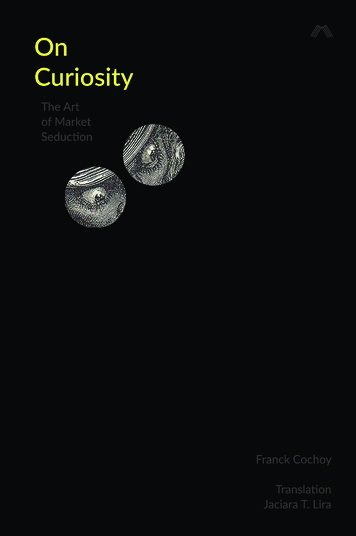
Transcription
M AT T E R I N G P R E S SMattering Press is an academic-led Open Access publisher thatoperates on a not-for-profit basis as a UK registered charity. It iscommitted to developing new publishing models that can widenthe constituency of academic knowledge and provide authorswith significant levels of support and feedback. All books areavailable to download for free or to purchase as hard copies. Moreat matteringpress.org.The Press’s work has been supported by: Centre for Invention andSocial Process (Goldsmiths, University of London), Centre forMobilities Research (Lancaster University), European Associationfor the Study of Science and Technology, Hybrid Publishing Lab,infostreams, Institute for Social Futures (Lancaster University),Open Humanities Press, and Tetragon.
Making th is b o o kMattering Press is keen to render more visible the unseen processes that go intothe production of books. We would like to thank Joe Deville, who acted as thePress’s coordinating editor for this book, Jenn Tomomitsu for the copy-editing,Tetragon for the production and typesetting, Sarah Terry for the proofreading,and Ed Akerboom at infostreams for the website design.C overMattering Press thanks Łukasz Dziedzic for Lato, our incomparable covertypeface. It remains one of the best free typefaces available and is released byhis foundry tyPoland under the free, libre and open source Open Font License.Cover art by Julien McHardy.
ON CURIOSITYThe Art ofMarket SeductionFRANCK COCHOYTranslated by Jaciara T. Lira
Originally published as De la curiosité: L’art de la séduction marchande Armand Colin, 2011.This translation Franck Cochoy, 2016. First published by Mattering Press, Manchester.Cover art Julien McHardy, 2016.Text design, typesetting and eBook by Tetragon, LondonFreely available online at www.matteringpress.org/books/on-curiosityThe conditions of the licence agreed with the original publisher mean that Mattering Press cannotgrant permission to reprint or reproduce this translation by any electronic, mechanical, or othermeans. Permission requests can be sent to the publisher at editors@matteringpress.org.The cover art is licensed under a Creative Commons By Attribution Non-Commercial Share Alikelicence. Under this licence, authors allow anyone to download, reuse, reprint, modify, distribute,and/or copy their work so long as the material is not used for commercial purposes and the authorsand source are cited and resulting derivative works are licensed under the same or similar licence.No permission is required from the authors or the publisher. Statutory fair use and other rights arein no way affected by the above.Read more about the licence at creativecommons.org/licenses/by-nc-sa/4.0/ISBN: 978-0-9955277-0-6 (pbk)ISBN: 978-0-9955277-1-3 (ebk)Mattering Press has made every effort to contact copyright holders and will be glad to rectify, infuture editions, any errors or omissions brought to our notice.
C ONTE N TSList of Figures 7Acknowledgements 9Teaser 111 · From Eve to Bluebeard: The Difficult Secularisation of Curiosity 172 · Bluebeard: Towards the Marketisation of Curiosity 353 · ‘Peep Shop’? An Anthropology of Window Displays 54The Effects of Locks 58The Effects of Mirrors 764 · ‘Teasing’ 99Packaging (Teasing, Scene 1) 100Advertising (Teaser, Scene 2) 111Continually Agitating Curiosity, or How to Lead a Consumer towardsWonderland 141Data Matrix 1495 · ‘Closer’ 157Door-closer 161Closer 169Appendix · Bluebeard 205Notes 211Bibliography 237
L IS T OF F IGURESI llustration 131415161718192021Lucas Cranach the Elder and Gustave Doré Frans Francken II; Gustave Doré The Progressive Grocer, February 1940, p. 127 The Progressive Grocer, February 1940, p. 59 The Progressive Grocer, February 1940, p. 58 Monsieur Plus, Bahlsen The Progressive Grocer, December 1957, p. 38 (detail) The Progressive Grocer, December 1957, pp. 35–40 Avenir, the Billboard Company that Keeps its Promises Neuf Ad: Do you Prefer Brunettes? Volvo Tentation Offers Daily Mail, 30 April 1914 (quoted in Field, 1959) Advertising Association Campaign, 1936 The Progressive Grocer, September 1929, p. 56 No More of This at Your Standard Stores (Wilson 1978) Fnac, Curiosity Agitator (v. 1) Data Matrix Door-closer (Nantes, August 2010) The Progressive Grocer, The magic door, February 1951, p. 201 The Progressive Grocer, August 1940, pp. 76–77 Mediapart, 16 June 2010,‘The Stolen Secrets of the Bettencourt Affair’ 691701847
on curiosityFig. 22 Le Figaro.fr and Le Figaro: Are you in favourof the total ban on the burqa? (22 and 23 April 2010) Fig. 23 Making Things Public, ZKM Fig. 24 LeMonde.fr and CoveritLive, 1 July 2011 Fig. 25 Closer, no.266, 17–23 July 2010 189191196197BoxesBox 1BoxBoxBoxBox82345Bluebeard and Psychoanalysis,or the Misfortunes of Misplaced Curiosity The Gift Package: The Economics of Surprise Volvo’s Tentation (Temptation) Offers ‘Adverteasing’: a technique that is older than we might think The Woerth-Bettencourt affair 37104128136180
AC K NOWLED GEMENTSI would like to extend my heartfelt thanks to all those whocontributed significantly to the writing of this book, through their assistance,their support, their contributions, their suggestions, their proofreading, thedocuments they passed on to me or suggested, and/or the opportunities theygave me to test my arguments during different symposiums and seminars:Luis Araujo, Nicolas Auray, Vincent Berry, Alexandra Bidet, Anni Borzeix,Emmanuel Boutet, Arlette Bouzon, Florence Brachet-Champsaur, Roland Canu,Johann Chaulet, Nathalie Cochoy, François Cooren, Marlène Coulomb, FrédéricCouret, Barbara Czarniawska, Caroline Datchary, François Dubet, SophieDubuisson-Quellier, Paul Du Gay, Marie-Anne Dujarier, Patrick Fridenson,Danielle Galliano, Martin Giraudeau, Mathieu Gousse, Johan Hagberg, BenoîtHeilbrunn, Jean-Claude Kaufmann, Emmanuel Kessous, Martin Kornberger,Aurélie Lachèze, Michèle Lalanne, Raphaël Lefeuvre, Claire Leymonerie, CeliaLury, Christian Licoppe, Alexandre Mallard, Liz McFall, Catherine Paradeise,Guillaume Queruel, Stefan Schwartzkopf, François de Singly, Jan Smolinski,Laurent Thévenot, Valérie Inès de la Ville, Lars Walter, and Steve Woolgar.I feel immensely indebted towards Jaciara Topley Lira and Joe Deville fortheir amazing work on the translation. Thank you so much, Joe, for your encouragement to publish this book in English at Mattering Press, and for working sohard to have it even better than the original version!More generally, I am very grateful to all those whose works nourished andinspired me: with a special thanks to Michel Callon and Bruno Latour.I also owe a great deal to the colleagues and institutions which generouslysupported my work: all of the partners from the Œnotrace project, CERTOP,my laboratory, and the sociology department at the University of Toulouse II in9
on curiosityFrance; the Center For Retailing, the Center for Consumer Science and Handels,the School of Business, Economics and Law of the University of Göteborg inSweden. These last three institutions welcomed me as Visiting Professor from2009 to 2013 and provided me with the ideal conditions for writing this book.Nor can I forget the support given to me by the Education Abroad Program andthe National Research Library Facility at University of California, Berkeley, towhich I owe some of the essential data on which my work is based.And finally, my gratitude goes to the natural and legal persons who allowedme to reproduce some of the illustrations included in this book (those being, andin order of appearance): the Samuel Courtauld Trust and the Courtauld Galleryin London for Lucas Cranach the Elder’s Adam and Eve; the KunsthistorischesMuseum of Vienna for Frans Francken the Younger’s Cabinet of Curiosities; theProgressive Grocer magazine for all the images I borrowed from that publication;the Saint-Michel biscuit factories for the Bahlsen advert; Claire Jonvelle andMyriam Szabo for the Myriam advert, produced by the CLM-BBDO agency;SFR for the Neuf Telecom advert; Volvo Cars for the leaflet on ‘Offres TentationVolvo’, produced by the Unedite agency; the History of Advertising Fund forthe English Advertising Association campaign; FNAC as an agitator of curiosity for the FNAC advertising spot; the journal Mediapart for its headline from16 June 2010.Of course, the statements expressed herein are mine alone.10
TE A SE RIn many respects, this book might derail some readers. Allthose who prefer to know what to expect, to reason on thebasis of well-established analytical frameworks and not torisk wasting their time on uncertain ramblings, are thusstrongly advised to go on their way.Seducing an audience – attracting the attention of a reader,catching a client’s attention, converting a non-believer, responding to a user’sexpectations, persuading a voter, etc. – often involves building technical deviceswhich play on people’s social dispositions. The excerpt above is one suchdevice (the irony!): it is a small, rhetorical machine which attempts to play onthe reader’s disposition towards conservatism and/or exploration. And thereare many others, especially within marketing settings, which will be my fieldof choice here. For example, in order to attract customers, we can use a sloganpromoting their penchant for repeating a habit (‘Nutella, spreading happinessevery day’); suggest a loyalty card which employs calculative capacities so asto better tie them to a future routine (‘5% discount on the brand’s products forcardholders’); propose a brand which appeals to a propensity for altruism (‘MaxHavelaar: great coffee [for] a great cause’); and so on. In other words, each oneof these little machines for equipping the relationship between an organisation and its audience ascribes an attitude to people, in both senses of the word:they assume that the intended targets already behave according to this or thatlogic, and/or supply them with a possible mode of action; they suggest a way ofbehaving which this or that person did not necessarily have in mind (as something inbuilt/as a possible idea) but in which they can recognise themselves orwhich is likely to catch their attention. With captation1 devices, the oppositionbetween human and non-human entities disappears, as does that between their11
on curiositysupposed privileges and respective ‘ontologies’, given that artefacts play a keyrole in defining or activating motives for action (and vice versa).I would like here to explore the dynamics of these devices and dispositions,by focusing on a particular disposition in greater depth – curiosity – and onthe particular devices which allow it to be expressed and spread throughoutsociety. Why curiosity? In my view, it would be better to answer this by askingthe opposite and even more intriguing question on which it is grounded: whynot curiosity? Why should it be curious to experience curiosity about curiosity?This book is the fruit of a twin astonishment: on the one hand, twenty years ofobserving commercial scenes convinced me that of the dispositions activatedby marketing devices, curiosity features prominently as a force behind everydayaction; and on the other, this finding only makes it more surprising that this banaldisposition is almost completely absent from the current sociological lexicon, orat least it was until very recently.2 Classical sociology, it seems, prefers conservative modes of action, first and foremost habit, which curiosity, however – withthe support of a related but equally neglected disposition: boredom – calls intoquestion. Curiosity leads us to move beyond ourselves, and thus helps us tofinally experience a little boredom, or perhaps more precisely weariness, aboutthis ‘habit’ we know so (too?) well; and to be curious about this curiosity (which,if not newer, is at least unusual) which calls habit into question. I am willingto wager that curiosity can help us understand how market professionals andtechnologies, and more generally all specialists in interpersonal relations, areable to reinvent a person’s identity and their mobility.3 They do this by playing onpeople’s inner motivations, in the hope of being better able both to draw thesepeople toward them and to make them act according to their wishes.I propose to conduct this exploration of curiosity by starting with an analysisof Bluebeard, the fairy tale written by Charles Perrault, given that this story isitself a pure curiosity machine which operates at the intersection (as we shallsee) of mythical history and the contemporary anthropology of this particulardisposition. The fact that exploring curiosity leads me to take a detour via popular culture – as well as religion, literature, literary criticism, history, philosophy,economics, psychology, management, and others – instead of sociology, whichis my primary discipline, merely illustrates the necessity that confronts the12
Teasersociologist who deals with curiosity, of drawing on sources other than those fromhis own discipline. It also illustrates the refreshing and potentially fertile natureof an exercise which consists in using the object being considered – curiosity,that is – as the means of its own exploration.As is often the case in stories, in Bluebeard it is what is said at the beginningrather than at the end that matters most. The best way of dealing with this textis to quote the opening directly:There was once a man who had fine houses, both in town and country, adeal of silver and gold plate, embroidered furniture, and coaches gilded allover with gold. But this man was so unlucky as to have a blue beard, whichmade him so frightfully ugly that all the women and girls ran away from him.One of his neighbors, a lady of quality, had two daughters who wereperfect beauties. He desired of her one of them in marriage, leaving to herchoice which of the two she would bestow on him. Neither of them wouldhave him, and they sent him backwards and forwards from one to the other,not being able to bear the thoughts of marrying a man who had a blue beard.Adding to their disgust and aversion was the fact that he already had beenmarried to several wives, and nobody knew what had become of them.Bluebeard, to engage their affection, took them, with their mother andthree or four ladies of their acquaintance, with other young people of theneighborhood, to one of his country houses, where they stayed a whole week.The time was filled with parties, hunting, fishing, dancing, mirth, andfeasting. Nobody went to bed, but all passed the night in rallying and jokingwith each other. In short, everything succeeded so well that the youngestdaughter began to think that the man’s beard was not so very blue after all,and that he was a mighty civil gentleman.As soon as they returned home, the marriage was concluded. Abouta month afterwards, Bluebeard told his wife that he was obliged to take acountry journey for six weeks at least, about affairs of very great consequence.He desired her to divert herself in his absence, to send for her friends andacquaintances, to take them into the country, if she pleased, and to makegood cheer wherever she was.13
on curiosity‘Here,’ said he, ‘are the keys to the two great wardrobes, wherein I havemy best furniture. These are to my silver and gold plate, which is not everyday in use. These open my strongboxes, which hold my money, both goldand silver; these my caskets of jewels. And this is the master key to all myapartments. But as for this little one here, it is the key to the closet at theend of the great hall on the ground floor. Open them all; go into each andevery one of them, except that little closet, which I forbid you, and forbidit in such a manner that, if you happen to open it, you may expect my justanger and resentment.’She promised to observe, very exactly, whatever he had ordered. Then he,after having embraced her, got into his coach and proceeded on his journey.Her neighbors and good friends did not wait to be sent for by the newlymarried lady. They were impatient to see all the rich furniture of her house,and had not dared to come while her husband was there, because of his bluebeard, which frightened them.4All French readers (and certainly many people in other countries!) know whathappened next:5 along with her friends, seduced by all the things, chests, andother furniture which she had been allowed to see, Bluebeard’s wife inevitablysuccumbed to the curiosity which drove her to explore, alone, the cabinet whichshe had promised not to open. There, reflected in a mirror of blood, she discovered the hanging bodies of all the other wives who had preceded her. She wasso horrified by the sight that she dropped the key to the floor; this then becamemarked by a bloodstain, which proved impossible to remove. Returning home,Bluebeard discovered that his wife had not kept her promise, and decided that,like his previous wives, she must die. After begging Bluebeard and shoutingfor help by desperately calling for her sister (‘Anne, sister Anne, do you seeanyone coming?’), the poor woman was fortunate to see her brothers arrive intime to save her and to kill Bluebeard. The inheritance from Bluebeard allowedhis surviving wife to remarry and to marry off her sisters, and to buy captains’commissions for her brothers.In the arguments that follow, I propose to draw on this tale reflexively. In spiteof Bluebeard, but also thanks to him, I intend to be (and to make those of my14
Teaserreaders who are not already) curious about curiosity. I will try to find keys androoms in addition to the small – all things considered! – number that appear inthe story of the man with the strange shock of facial hair. As we shall see, thereare two other secret rooms in Bluebeard’s house that are yet to be explored.These rooms are neither those more sumptuous ones located upstairs, nor onthe ground floor, like the room of horrors; we will nonetheless visit these manyrooms carefully (chapter 2). Like the archaeological foundations of the house,the first forgotten room was built well before Bluebeard somewhere in the cellar.This room contains the complete ancient anthropological history of curiosity,and more specifically, the Bible and the cabinets of curiosity that precede, butalso modify this early history (chapter 1). The second room was built later andis higher up, in the attic, and is filled with the contemporary uses of curiosity inmarkets, whether window displays (chapter 3) or ‘teasing’ devices, intended toactivate curiosity further and in different ways (chapter 4). By exploring the verysmallest nooks in each of the rooms in the story of Bluebeard, I aim to uncover adeeper level through which the tale operates (a transitional space between thetwo forgotten rooms), as well as to reveal both the anthropological persistenceand constant renewal of curiosity which constitutes – as we come to realise bythe end of the fairy tale, and occurring today as much as it ever has – one of theprinciple modes of action capable of changing both people and their worlds.15
1FRO M EV E TO BLUE BE AR D:THE DIF F ICULTS EC U LARISATION OFCU RIOSITYIt is well known that Perrault’s tales, far from being original,are rather revised literary versions of popular tales, often drawing on oraltraditions (Soriano 1977). The tale of Bluebeard follows this model, but in avery particular way. It follows the model insofar as its account of the dangersof curiosity, as in the themes dealt with by many other fairy tales, is far fromnew. However, things are nevertheless different. The story not only recountsa popular fairy tale,1 but also possibly retells historical events. The models forBluebeard perhaps include: in France, Gilles de Rais, Joan of Arc’s companion,who murdered a number of children and was hanged and then burned for hiscrimes and acts of witchcraft (Cazelles and Wells 1999); and, in England, HenryVIII, who executed two of his six wives. We can also say, with even greater certainty, that it retells the ‘tale of tales’: the most obvious source of inspiration(whether direct or indirect) for Bluebeard seems to me to be the Bible and itsstory of the tree of knowledge and of Eve and the Serpent:Now the serpent was more crafty than any of the wild animals the LordGod had made. He said to the woman, ‘Did God really say, “You mustnot eat from any tree in the garden”?’ The woman said to the serpent, ‘Wemay eat fruit from the trees in the garden’, but God did say, ‘You must noteat fruit from the tree that is in the middle of the garden, and you mustnot touch it, or you will die’. ‘You will not certainly die’, the serpent said17
on curiosityto the woman. ‘For God knows that when you eat from it your eyes willbe opened, and you will be like God, knowing good and evil’. When thewoman saw that the fruit of the tree was good for food and pleasing tothe eye, and also desirable for gaining wisdom, she took some and ateit. She also gave some to her husband, who was with her, and he ate it.Then the eyes of both of them were opened, and they realised they werenaked; so they sewed fig leaves together and made coverings for themselves. Then the man and his wife heard the sound of the Lord God ashe was walking in the garden in the cool of the day, and they hid fromthe Lord God among the trees of the garden. But the Lord God called tothe man, ‘Where are you?’ He answered, ‘I heard you in the garden, andI was afraid because I was naked; so I hid’. And he said, ‘Who told youthat you were naked? Have you eaten from the tree that I commanded younot to eat from?’ The man said, ‘The woman you put here with me – shegave me some fruit from the tree, and I ate it’. Then the Lord God said tothe woman, ‘What is this you have done?’ The woman said, ‘The serpentdeceived me, and I ate’.2As we know, God then punishes the three protagonists: he condemns the Serpentto crawl and to eat dust, the woman to give birth in pain and to live under thedomination of her husband, and Adam to cultivate the soil (and, upon his death)to finally return to it himself.The analogy between Bluebeard and Genesis is as strong as it is evident: inboth stories a mysterious agent (God or man) prohibits a woman from approaching one item amongst many others; that same or another item stimulates hercuriosity, pushing her to contravene the initial prohibition, and either punishesher or tries to punish the person (or people) who were unable to keep theirpromise. In both cases, the force (incentive?) of the temptation is exactly thesame: access is granted to all the trees or cabinets, with the exception of one.There are of course very considerable differences between the two stories,which might outweigh their similarities, but before exploring these differencesand their meanings, I would like to emphasise the extent of the parallels we canestablish between the two.18
From Eve to Bluebeard: the Difficult Secularisation of CuriosityFig. 1. Lucas Cranach the Elder3 and Gustave Doré4The story of Bluebeard is nothing more than a profane variation of a veryold, mythical story. As such, curiosity defies the sacred: it is a disposition thatis deeply linked to an old anthropological scheme, not limited to the JudaeoChristian tradition. This scheme relies on the privileged nature of the relationshipof knowledge between the gods and humankind, as in the myths of Icarus andPrometheus, and/or on their being costs for sampling and discovering what isforbidden, as in the myths of Pandora5 and Psyche6 (or more recently, of LadyGodiva7 or the Lady of Shalott8). The mythical or religious roots of Bluebeardlend the question of curiosity a particular depth. It is not just any disposition;it is, on the contrary, the very first disposition which humankind gave itself; it iscuriosity and curiosity alone which is at the beginning of our history; after Godprovided the main elements and the scenery, it is curiosity that sets the humanadventure in motion. At least in the Judaeo-Christian imagination, curiositytherefore intervenes long before ‘habit’ and ‘self-interest’, which sociology andeconomics nevertheless try to impose, one set in opposition to the other, likeprimitive matrices for all behaviour!The mythical and religious origin of curiosity lend it a particular quality,by reminding us of its relation to sacred questions, to the ordering of knowledge, and to respect for Scripture. Before the development of modern science,19
on curiositycuriosity was at the heart of the tension between natural philosophy and religion, and dealing correctly with this tension was a major challenge for socialorder as well as for religious power. For the fathers of the Church, the problemconsisted in making the teachings of Aristotle, for whom ‘all men, by naturedesire to know’ (Metaphysics book Ab 980 a 21), compatible with Scripture,which forbade access to the tree of knowledge. The difficulty is best expressedin Saint Augustine’s famous confession concerning curiosity. On the one hand,Saint Augustine recognises that curiosity (curiositas) is a passion which, like itstwo sisters’ pleasure (voluptas) and pride (superbia), is from both a spiritual andbiological point of view inherent to the human condition:To this is added another form of temptation more manifoldly dangerous.For besides that concupiscence of the flesh which consisteth in the delightof all senses and pleasures, wherein its slaves, who go far from Thee, wasteand perish, the soul hath, through the same senses of the body, a certain vainand curious desire, veiled under the title of knowledge and learning, not ofdelighting in the flesh, but of making experiments through the flesh. Theseat whereof being in the appetite of knowledge, and sight being the sensechiefly used for attaining knowledge, it is in Divine language called The lustof the eyes (Saint Augustine 2005: 113).On the other hand, Saint Augustine is wary of the dangers of curiosity, whichhe sees as steering us towards futile and vain knowledge and distracting us fromserious and pious thought:From this disease of curiosity are all those strange sights exhibited in thetheatre. Hence men go on to search out the hidden powers of nature (whichis besides our end), which to know profits not, and wherein men desire nothing but to know. Hence also, if with that same end of perverted knowledgemagical arts be enquired by. Hence also in religion itself, is God tempted,when signs and wonders are demanded of Him, not desired for any good end,but merely to make trial of [ ] in how many most petty and contemptiblethings is our curiosity daily tempted, and how often we give way, who can20
From Eve to Bluebeard: the Difficult Secularisation of Curiosityrecount? How often do we begin as if we were tolerating people telling vainstories, lest we offend the weak; then by degrees we take interest therein!I go not now to the circus to see a dog coursing a hare; but in the field, ifpassing, that coursing peradventure will distract me even from some weightythought, and draw me after it: not that I turn aside the body of my beast,yet still incline my mind thither. And unless Thou, having made me see myinfirmity didst speedily admonish me either through the sight itself by somecontemplation to rise towards Thee, or altogether to despise and pass it by,I dully stand fixed therein (Saint Augustine 2005: 114).In his confession, Saint Augustine identifies an interesting series of types ofcuriosity which range in form from the most anodyne to the most dangerous.The first category includes all kinds of ‘spectacle’, such as the dog race mentionedin the quote, or the lizard and spider catching flies, which in the process catchour attention, or the ‘frivolous’ gossip which we at first listen to in order toavoid offending the speaker, but which we then find ourselves obtaining greatpleasure from. All these forms of curiosity are reprehensible. It is less becauseof the objects of our curiosity, which are of no particular importance, and morebecause of their effect: they distract us from the Augustinian quest for knowledgeof God and of oneself.9 A second category (just as reprehensible) concerns theenigmatic and unhealthy curiosity we experience with regard to unpleasant sightswhich functions as a perverse form of distraction: ‘For what pleasure hath it,to see in a mangled carcase what will make you shudder? And yet if it be lyingnear, they flock thither, to be made sad, and to turn pale. Even in sleep they areafraid to see it’ (Saint Augustine 2005: 114). It must be said, in passing, thatthis second, horrific form of curiosity is precisely the kind we find operating inthe last part of Bluebeard. It does not operate through Bluebeard’s wife (who hasno way of knowing what is on the other side of the door, and who turns awayand leaves immediately, truly horrified by what she discovers), but through thereader: it is the ‘gory’ side of the tale that makes it so particularly fascinatingfor readers.10 Finally, a third, more significant category of curiosity involves thesearch for the ‘hidden powers of nature (which is besides our end)’. This is, inother words, the forbidden fruit of the tree of knowledge. Saint Augustine – like21
on curiositycontemporaries of his such as Apuleius (Tasitano 1989) – thought that theheretical search for this type of knowledge could not be pursued other thanby ‘magic’. For centuries, the idea of an almost obligatory link between ‘forbidden knowledge’ (Harrison 2001) and ‘the curious sciences’ – that is to say,the heretical practices of alchemy, astrology, necromancy, Hermeticism, andwitchcraft – served to disqualify and suppress (often violently and, from thethirteenth century, with the help of the Inquisition) the numerous attempts topursue knowledge beyond the sphere of religious thought, thus impeding thedevelopment of
7 LIST OF FIGURES Illustrations Fig. 1 Lucas Cranach the Elder and Gustave Doré 19 Fig. 2 Frans Francken II; Gustave Doré 39 Fig. 3 The Progressive Grocer, February 1940, p. 127 77 Fig. 4 The Progressive Grocer, February 1940, p. 59 79 Fig. 5 The Progressive Grocer, February 1940, p. 58 93 Fig. 6 Monsieur Pl




